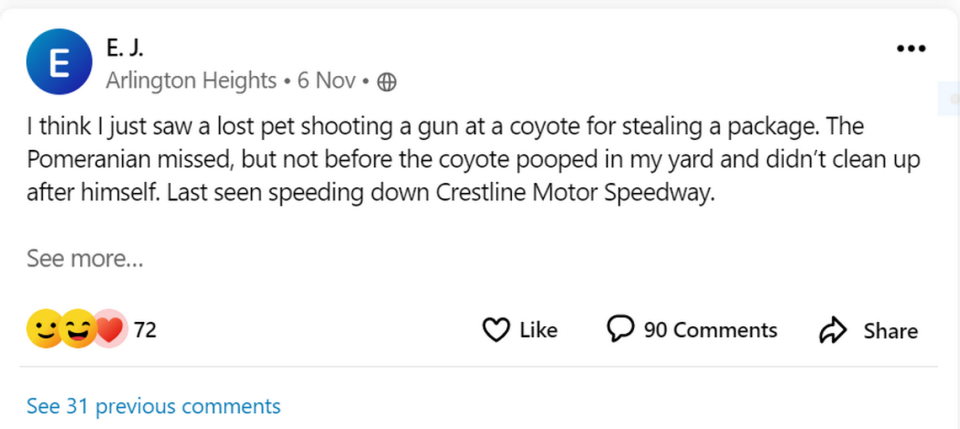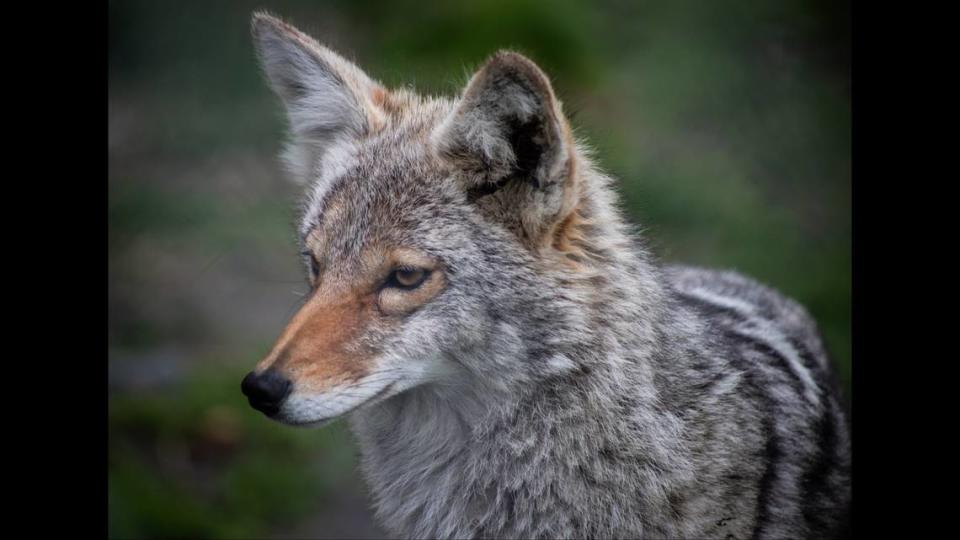Report of coyote biting children in Texas city begs question: Why are they at urban park?
If coyotes seem to be everywhere in North Texas these days, it’s probably because they are.
An Arlington park was closed this week after reports of a coyote biting children surfaced. Arlington Animal Services set traps around the park, but has so far been unsuccessful at capturing the animal.
“Animal Services will set out additional traps at the park this evening and will continue patrols to locate and tranquilize the coyote,” the City of Arlington stated in a social media post.
⚡ More trending stories:
→ Texas to 'spring forward': When daylight saving time begins
→ TikTok star Keith Lee gives love to 'dopest restaurant' in Fort Worth
→ Why Texas should care about return of La Nina.
What the city will do with animal if it is captured is still not known. Coyotes are considered nuisance animals in Texas, which means they are not protected by law.
Native to North America, they are smaller cousins to the wolf. They are a resilient species that can be found roaming ranch land or creeping around darkened urban street corners and alleys. They are opportunistic feeders — equally content in killing a pet cat or foraging through a pile of garbage.
But when urban coyotes become habituated, shedding their fear of humans, then conflicts occur.
“And that becomes a human safety problem,” Mike Bodenchuk, a wildlife biologist who heads the Texas Wildlife Services Program, a consortium of federal and state agencies working on wildlife issues, told the Star-Telegram. “We’ve seen that in the Metroplex, over and over. Somebody’s feeding the coyotes and then all of a sudden they start hanging around bus stops for kids and they start killing pets in backyards. And that’s a problem. That’s a growing human safety problem.”
Everyone, it seems, has a coyote sighting story to tell. If not, a solution in controlling the animals.
A poster on nextdoor.com cheekily shared a joke: “I think I just saw a lost pet shooting a gun at a coyote for stealing a package. The Pomeranian missed, but not before the coyote pooped in my yard and didn’t clean up after himself. Last seen speeding down Crestline Motor Speedway.”

All kidding aside, can you really shoot a coyote? In Fort Worth?
Bodenchuk said, yes and no.
“Coyotes are a nuisance animal and are not protected under Texas law,” he said. “In the rural counties you can shoot a coyote. You do not need a license to shoot a coyote.”
But inside Fort Worth city limits, discharging a firearm is illegal. So, no, he said.

What are coyotes, and where do they roam?
Coyote packs usually consist of an adult pair, three to four pups and the yearlings from the previous year. They breed around Valentine’s Day and the females give birth to a new litter by April or May.
Once a coyote pup reaches two years of age, they are normally kicked out of the pack.
“Coyote packs start shedding members right around late fall, getting ready for the breeding season,” Bodenchuk said.
Urban female coyotes tend to keep an older female around to help with the pups. This behavior distinguishes city coyotes from their ranch or wild cousins.
“We call them little sisters, big sisters,” Bodenchuk said. “They help the female raise these pups and that is more common in an urban area than in a rural area. Because there’s more groceries in the urban area.”
Alpha females in coyote packs are usually three years or older, and will only tolerate another female to help care for her pups.
“That’s the only female she’s going to tolerate in her territory,” the biologists said. “In the ranch country that kind of (female) would get kicked out of the territory.”
Why? Because coyote packs regulate membership based on the abundance of food in the territory. Wild dogs have to hunt for food in ranch or wild lands. While their city counterparts have plenty of food to forage or kill.
“Territories are established to protect resources,” Bodenchuk said.
Sightings of the wild canines become more frequent as a pack starts shedding members in preparation of the breeding season. Reports of a single coyote roaming a neighborhood in winter may mean a pack has kicked out the animal.
“It could be one of the pups from last year that got kicked out of his territory, (and now gets) to live between the territories or between the spaces where the adults would defend,” he said.
An urban coyote’s range is roughly one square mile, or 600-650 acres, according to wildlife biologist Mike Bodenchuk. City coyotes can thrive in a much smaller area because of an abundance of food.
As the breeding season rolls around, the adult male of the pack will aggressively defend its territory.
“He keeps other males out of there from the previous year,” Bodenchuk said. “And the closer we get to pups being born in April and May, they get very aggressive towards other canines in their territory.”
This is where conflicts with humans occur, he said.
“This gets directly to the kind of conflicts that we might see in an urban area,” Bodenchuk said. “Somebody’s walking a dog or somebody’s dog is off the leash. (The coyote) isn’t looking at food, it’s looking at another canine in their territory and they will try and run it off. Or even attack it.”
What to do when around coyotes
Be as big and loud as possible. Do not run or turn your back. Wave your arms, clap your hands, and shout in an authoritative voice.
Bodenchuk said shoot the animal with a paintball gun if you spot one in your backyard.
Pick up leftover pet food if you feed pets outside.
When you do come across a coyote, call Fort Worth Animal Care & Control or the police department.

